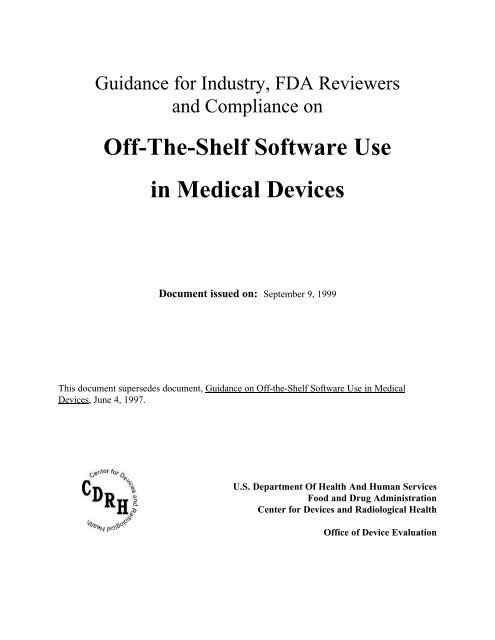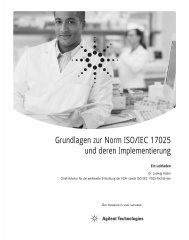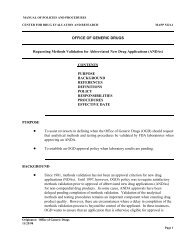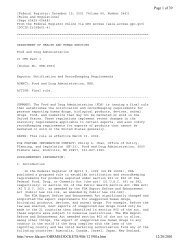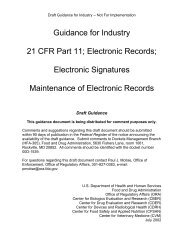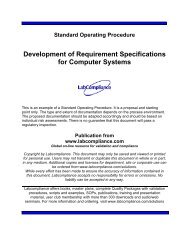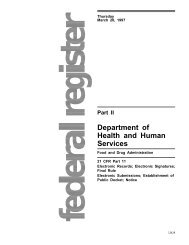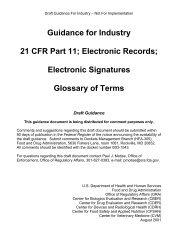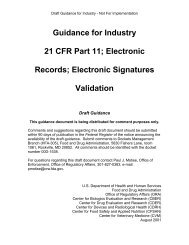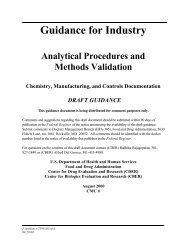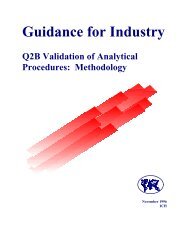Guidance for Off-The-Shelf Software Use in Medical Devices
Guidance for Off-The-Shelf Software Use in Medical Devices
Guidance for Off-The-Shelf Software Use in Medical Devices
You also want an ePaper? Increase the reach of your titles
YUMPU automatically turns print PDFs into web optimized ePapers that Google loves.
<strong>Guidance</strong> <strong>for</strong> Industry, FDA Reviewersand Compliance on<strong>Off</strong>-<strong>The</strong>-<strong>Shelf</strong> <strong>Software</strong> <strong>Use</strong><strong>in</strong> <strong>Medical</strong> <strong>Devices</strong>Document issued on: September 9, 1999This document supersedes document, <strong>Guidance</strong> on <strong>Off</strong>-the-<strong>Shelf</strong> <strong>Software</strong> <strong>Use</strong> <strong>in</strong> <strong>Medical</strong><strong>Devices</strong>, June 4, 1997.U.S. Department Of Health And Human ServicesFood and Drug Adm<strong>in</strong>istrationCenter <strong>for</strong> <strong>Devices</strong> and Radiological Health<strong>Off</strong>ice of Device Evaluation
PrefacePublic CommentComments and suggestions may be submitted at any time <strong>for</strong> Agency consideration toDonna-Bea Tillman, <strong>Off</strong>ice of Device Evaluation at dbt@cdrh.fda.gov or at 301-443-8517. Comments may not be acted upon by the Agency until the document is next revisedor updated. For questions regard<strong>in</strong>g the use or <strong>in</strong>terpretation of this guidance contactDonna-Bea Tillman at dbt@cdrh.fda.gov or at 301-443-8517. Questions regard<strong>in</strong>g theuse or <strong>in</strong>terpretation of this guidance <strong>for</strong> a particular device should be directed to theappropriate ODE review division.Additional CopiesWorld Wide Web/CDRH home page: http://www.fda.gov/cdrh/ode/1252.pdf, or CDRHFacts on Demand at 1-800-899-0381 or 301-827-0111, specify number 1252 whenprompted <strong>for</strong> the document shelf number.OTS <strong>Software</strong> <strong>Guidance</strong>, F<strong>in</strong>al page ii
Table of Contents1 OVERVIEW.......................................................................................................................................11.1 Introduction and Background............................................................................................................................11.2 Purpose / Scope ................................................................................................................................................11.3 Def<strong>in</strong>itions...........................................................................................................................................................21.4 OTS <strong>Software</strong> Decision Schematic ...................................................................................................................4Figure 1-1. OTS <strong>Software</strong> Decision Schematic...................................................................4Table 1-1. Documentation Summary from Figure 1-1 ...............................................................52 OTS SOFTWARE USE .....................................................................................................................52.1 BASIC DOCUMENTATION <strong>for</strong> OTS <strong>Software</strong>.................................................................................................52.2 OTS <strong>Software</strong> Hazard Analysis .........................................................................................................................72.3 OTS <strong>Software</strong> Hazard Mitigation.......................................................................................................................8Figure 2-1. Typical Hazard Analysis and Mitigation.............................................................9Table 2-1. Injury Reduction Countermeasures ..................................................................112.4 Describe and Justify Residual Risk .................................................................................................................112.5 SPECIAL DOCUMENTATION <strong>for</strong> OTS <strong>Software</strong> ..........................................................................................113 OTS SOFTWARE USED IN MARKETING APPLICATIONS...........................................................123.1 Examples..........................................................................................................................................................123.1.1 Corneal Topographer ..................................................................................................................... 123.1.2 Per<strong>in</strong>eometer ................................................................................................................................. 133.1.3 Implantable <strong>Medical</strong> Device Programmers...................................................................................... 133.2 510(k) Issues with OTS <strong>Software</strong>....................................................................................................................153.2.1 OTS <strong>Software</strong> Changes Requir<strong>in</strong>g a 510(k) .................................................................................... 163.2.2 Exemption of Laboratory In<strong>for</strong>mation Management Systems .......................................................... 163.3 IDE Issues with OTS <strong>Software</strong> ........................................................................................................................163.4 Exemption of Certa<strong>in</strong> Diagnostic <strong>Devices</strong> .......................................................................................................173.5 PMA Issues with OTS <strong>Software</strong> ......................................................................................................................173.6 Artificial Intelligence..........................................................................................................................................173.7 Product Label<strong>in</strong>g..............................................................................................................................................184 BIBLIOGRAPHY.............................................................................................................................185 APPENDICES.................................................................................................................................195.1 Operat<strong>in</strong>g Systems ..........................................................................................................................................195.2 Utilities and Drivers...........................................................................................................................................205.3 Local Area Networks (LANs) ...........................................................................................................................205.3.1 Requirements Analysis................................................................................................................... 215.3.2 Implementation .............................................................................................................................. 225.4 Device Master Files..........................................................................................................................................225.5 Ma<strong>in</strong>tenance and Obsolescence.....................................................................................................................235.5.1 Safety ............................................................................................................................................ 235.5.2 Design ........................................................................................................................................... 245.5.3 Verification and Validation.............................................................................................................. 245.5.4 Installation ..................................................................................................................................... 255.5.5 Obsolescence ................................................................................................................................ 255.5.6 Change control............................................................................................................................... 25Numbers <strong>in</strong> square brackets [##] appear<strong>in</strong>g <strong>in</strong> this guidance refer to citations <strong>in</strong> the Bibliography (Section 4)OTS <strong>Software</strong> <strong>Guidance</strong>, F<strong>in</strong>al page iii
1 Overview1.1 Introduction and Background<strong>Off</strong>-the-shelf (OTS) software is commonly be<strong>in</strong>g considered <strong>for</strong> <strong>in</strong>corporation <strong>in</strong>to medicaldevices as the use of general purpose computer hardware becomes more prevalent. <strong>The</strong> use ofOTS software <strong>in</strong> a medical device allows the manufacturer to concentrate on the applicationsoftware needed to run device-specific functions. However, OTS software <strong>in</strong>tended <strong>for</strong> generalpurpose comput<strong>in</strong>g may not be appropriate <strong>for</strong> a given specific use <strong>in</strong> a medical device. <strong>The</strong>medical device manufacturer us<strong>in</strong>g OTS software generally gives up software life cycle control,but still bears the responsibility <strong>for</strong> the cont<strong>in</strong>ued safe and effective per<strong>for</strong>mance of the medicaldevice.This guidance document was developed to address the many questions asked by medical devicemanufacturers regard<strong>in</strong>g what they need to provide <strong>in</strong> a pre-market submission to the FDA whenthey use OTS software. <strong>The</strong> specific response to these questions depends on the medical device <strong>in</strong>question and the impact on patient, operator, or bystander safety if the OTS software fails. Thus,the answer to the question, “What do I need to document?” may differ and is based on the riskanalysis that is an <strong>in</strong>tegral part of design<strong>in</strong>g a medical device. <strong>The</strong> detail of documentation to beprovided to FDA and the level of life cycle control necessary <strong>for</strong> the medical device manufacturer<strong>in</strong>crease as severity of the hazards to patients, operators, or bystanders from OTS software failure<strong>in</strong>creases.This document lays out <strong>in</strong> broad terms how the medical device manufacturer can consider what isnecessary to document <strong>for</strong> submission to the agency. A BASIC set of need-to-document items isrecommended <strong>for</strong> all OTS software, and a detailed discussion is provided on additional(SPECIAL) needs and responsibilities of the manufacturer when the severity of the hazards fromOTS software failure become more significant.1.2 Purpose / ScopeThis guidance document represents the agency’s current th<strong>in</strong>k<strong>in</strong>g on the documentation thatshould be provided <strong>in</strong> premarket submissions <strong>for</strong> medical devices us<strong>in</strong>g OTS software. It doesnot create or confer any rights <strong>for</strong> or on any person and does not operate to b<strong>in</strong>d FDA or thepublic. An alternative approach may be used if such approach satisfies the requirements of theapplicable statute, regulations or both. <strong>The</strong> FDA uses mandatory language, such as shall, must,and require, when referr<strong>in</strong>g to statutory or regulatory requirements. <strong>The</strong> FDA uses nonmandatorylanguage such as should, may, can, and recommend when referr<strong>in</strong>g to guidance.<strong>The</strong> purpose of this document is to describe the <strong>in</strong><strong>for</strong>mation that generally should be provided <strong>in</strong> amedical device application <strong>in</strong>volv<strong>in</strong>g OTS software. This <strong>in</strong><strong>for</strong>mation is <strong>in</strong> addition to thedocumentation described <strong>in</strong> the <strong>Guidance</strong> <strong>for</strong> the Content of Premarket Submissions <strong>for</strong> <strong>Software</strong>OTS <strong>Software</strong> <strong>Guidance</strong>, F<strong>in</strong>al page 1
Conta<strong>in</strong>ed <strong>in</strong> <strong>Medical</strong> <strong>Devices</strong> [4]. Many of the pr<strong>in</strong>ciples outl<strong>in</strong>ed here<strong>in</strong> may also be helpful todevice manufacturers <strong>in</strong> establish<strong>in</strong>g design controls and validation plans <strong>for</strong> use of off-the-shelfsoftware <strong>in</strong> their devices. This guidance discusses key elements reviewers should look <strong>for</strong> <strong>in</strong> thesubmission thereby provid<strong>in</strong>g a common basel<strong>in</strong>e from which both manufacturers and reviewerscan operate. This should improve predictability of agency <strong>in</strong>teraction with sponsors regard<strong>in</strong>gapplications <strong>in</strong>volv<strong>in</strong>g OTS software.<strong>The</strong> guidance provided <strong>in</strong> this document reflects a safety-based approach to risk management andis designed to be consistent with <strong>in</strong>ternational standards on risk management. Exist<strong>in</strong>g<strong>in</strong>ternational standards <strong>in</strong>dicate that the estimation of risk should be considered as the product ofthe severity of harm and the probability of occurrence of harm. Probabilities of occurrence arecalculated based on cl<strong>in</strong>ical and eng<strong>in</strong>eer<strong>in</strong>g considerations. On the cl<strong>in</strong>ical side, manufacturersuse patient populations, user skill sets, label<strong>in</strong>g and risk benefit analysis to calculate risk andacceptable risk levels. On the software eng<strong>in</strong>eer<strong>in</strong>g side, probabilities of occurrence wouldnormally be based on software failure rates. However, software failures are systematic <strong>in</strong> natureand there<strong>for</strong>e their probability of occurrence can not be determ<strong>in</strong>ed us<strong>in</strong>g traditional statisticalmethods.Because the risk estimates <strong>for</strong> hazards related to software cannot easily be estimated based onsoftware failure rates, CDRH has concluded that eng<strong>in</strong>eer<strong>in</strong>g risk management <strong>for</strong> medical devicesoftware should focus on the severity of the harm that could result from the software failure.Hazard Analysis is def<strong>in</strong>ed as the identification of Hazards and their <strong>in</strong>itiat<strong>in</strong>g causes [IEC 60601-1-4]. Based on the def<strong>in</strong>ition of Risk Analysis <strong>in</strong> ISO DIS 14971 and EN 1441, hazard analysis isactually a subset of risk analysis; because risk analysis <strong>for</strong> software cannot be based on probabilityof occurrence, the actual function of risk analysis <strong>for</strong> software can then be reduced to a hazardanalysis function. Technically speak<strong>in</strong>g, the use of either term risk or hazard analysis isappropriate. However, CDRH has chosen to use the term hazard analysis to re<strong>in</strong><strong>for</strong>ce theconcept that calculat<strong>in</strong>g risk based on software failure rates is generally not justified, and that it ismore appropriate to manage software safety risk based on the severity of harm rather then thesoftware failure rates.1.3 Def<strong>in</strong>itionsFollow<strong>in</strong>g a safety-based approach to risk analysis, we def<strong>in</strong>e:Hazard – A possible source of danger or a condition which could result <strong>in</strong> human <strong>in</strong>jury.Hazard Analysis – Identification of hazards and their <strong>in</strong>itiat<strong>in</strong>g causes. [IEC 60601-1-4]Hazard Mitigation – Reduction <strong>in</strong> the severity of the hazard, the likelihood of the occurrence, orboth.Major Level of Concern – <strong>The</strong> Level of Concern is major if operation of the software associatedwith device function directly affects the patient, operator, and/or bystander so that failures orlatent flaws could result <strong>in</strong> death or serious <strong>in</strong>jury to the patient, operator, and/or bystander, or ifit <strong>in</strong>directly affects the patient, operator, and/or bystander (e.g., through the action of careOTS <strong>Software</strong> <strong>Guidance</strong>, F<strong>in</strong>al page 2
provider) such that <strong>in</strong>correct or delayed <strong>in</strong><strong>for</strong>mation could result <strong>in</strong> death or serious <strong>in</strong>jury to thepatient, operator, and/or bystander.M<strong>in</strong>or Level of Concern – <strong>The</strong> Level of Concern is m<strong>in</strong>or if failures or latent design flaws wouldnot be expected to result <strong>in</strong> any <strong>in</strong>jury to the patient, operator, and/or bystander.Moderate Level of Concern– <strong>The</strong> Level of Concern is moderate if the operation of the softwareassociated with device function directly affects the patient, operator, and/or bystander so thatfailures or latent design flaws could result <strong>in</strong> non-serious <strong>in</strong>jury to the patient, operator, and/orbystander, or if it <strong>in</strong>directly affects the patient, operator, and/or bystander (e.g., through the actionof the care provider) where <strong>in</strong>correct or delayed <strong>in</strong><strong>for</strong>mation could result <strong>in</strong> non-serious <strong>in</strong>jury ofthe patient, operator, and/or bystander.<strong>Off</strong>-the-<strong>Shelf</strong> <strong>Software</strong> (OTS software) – A generally available software component, used by amedical device manufacturer <strong>for</strong> which the manufacturer can not claim complete software lifecycle control.Risk Analysis – Investigation of available <strong>in</strong><strong>for</strong>mation to identify hazards and to estimate risks.[ISO DIS 14971]Risk Control – the process through which decisions are reached and implemented <strong>for</strong> reduc<strong>in</strong>grisks to, or ma<strong>in</strong>ta<strong>in</strong><strong>in</strong>g risks with<strong>in</strong>, specified limits. [ISO DIS 14971]Safety – In the regulation of medical devices, safety means that the probable benefits to health <strong>for</strong>its <strong>in</strong>tended use when accompanied by adequate directions and warn<strong>in</strong>gs aga<strong>in</strong>st unsafe use,outweigh any probable risks. In this guidance we will use the words “safety and effectiveness” torem<strong>in</strong>d ourselves that safety is only mean<strong>in</strong>gful <strong>in</strong> the context of the benefit-risk considerationsand the label<strong>in</strong>g.Serious Injury – as adopted from the <strong>Medical</strong> Device Report<strong>in</strong>g (MDR) regulation <strong>in</strong> the Codeof Federal Regulations 21 CFR 803.3 (aa), means an <strong>in</strong>jury or illness that:1. is life threaten<strong>in</strong>g,2. results <strong>in</strong> permanent impairment of a body function or permanent damage to a body structure,or3. necessitates medical or surgical <strong>in</strong>tervention to preclude permanent impairment of a bodyfunction or permanent damage to a body structure.Permanent – <strong>for</strong> the purpose of this subpart, permanent means irreversible impairment or damageto a body structure or function exclud<strong>in</strong>g trivial impairment or damage.Other software term<strong>in</strong>ology used <strong>in</strong> this document is def<strong>in</strong>ed <strong>in</strong> FDA's Glossary of ComputerizedSystem and <strong>Software</strong> Development Term<strong>in</strong>ology [6].OTS <strong>Software</strong> <strong>Guidance</strong>, F<strong>in</strong>al page 3
1.4 OTS <strong>Software</strong> Decision Schematic<strong>The</strong> content of the application support<strong>in</strong>g use of OTS <strong>Software</strong> <strong>in</strong> a medical device depends onthe results of the hazard analysis. Figure 1-1 provides a schematic of the decision process and atable of contents <strong>for</strong> Section 2 of this guidance document.Figure 1-1. OTS <strong>Software</strong> Decision SchematicDoes the device <strong>in</strong>clude OTS <strong>Software</strong>?(see def<strong>in</strong>ition, section 1.3)DoneNoYesProvide BASIC DOCUMENTATION(see section 2.1)Per<strong>for</strong>m Device & OTS <strong>Software</strong> Hazard AnalysisDoes the OTS <strong>Software</strong> present a MINOR LEVEL OF CONCERN (LOC)?(see section 2.2)DoneYesM<strong>in</strong>or LOCNoHazard Mitigation(see section 2.3)Describe and Justify Residual Risk(see section 2.4)Does the OTS <strong>Software</strong> (after hazard mitigation) represent aMAJOR LEVEL OF CONCERN?NoM<strong>in</strong>or orModerate LOCYesMajor LOCDoneProvide OTS <strong>Software</strong>SPECIAL DOCUMENTATION(see section 2.5)OTS <strong>Software</strong> <strong>Guidance</strong>, F<strong>in</strong>al page 4
Table 1-1 summarizes the recommended contents <strong>for</strong> an OTS <strong>Software</strong> submission based onFigure 1-1.Table 1-1. Documentation Summary from Figure 1-1M<strong>in</strong>or Level of Concern be<strong>for</strong>e mitigationsHazard AnalysisBasic DocumentationM<strong>in</strong>or Level of Concern after mitigationsHazard AnalysisBasis DocumentationHazard MitigationsModerate Level of ConcernHazard AnalysisBasis DocumentationHazard MitigationsDescribe and Justify Residual RiskMajor Level of Concern after mitigationsHazard AnalysisBasic DocumentationHazard MitigationsDescribe and Justify Residual RiskSpecial Documentation2 OTS <strong>Software</strong> <strong>Use</strong>2.1 BASIC DOCUMENTATION <strong>for</strong> OTS <strong>Software</strong><strong>The</strong> OTS <strong>Software</strong> BASIC DOCUMENTATION is <strong>in</strong>tended to answer the follow<strong>in</strong>g questions:1. What is it? - For each component of OTS <strong>Software</strong> used, specify the follow<strong>in</strong>g:• Title and Manufacturer of the OTS <strong>Software</strong>.• Version Level, Release Date, Patch Number and Upgrade Designation as appropriate.• Any OTS <strong>Software</strong> documentation that will be provided to the end user.• Why is this OTS <strong>Software</strong> appropriate <strong>for</strong> this medical device?OTS <strong>Software</strong> <strong>Guidance</strong>, F<strong>in</strong>al page 5
• What are the expected design limitations of the OTS <strong>Software</strong>?Note: <strong>The</strong> medical device manufacturer should only use the OTS <strong>Software</strong> as specified <strong>in</strong> anappropriate document, i.e., design record. If the version of the OTS <strong>Software</strong> changes, theappropriate document should be updated to reflect the change.2. What are the Computer System Specifications <strong>for</strong> the OTS <strong>Software</strong>? - For whatconfiguration will the OTS software be validated? Specify the follow<strong>in</strong>g:• Hardware specifications: processor (manufacturer, speed, and features), RAM (memorysize), hard disk size, other storage, communications, display, etc.• <strong>Software</strong> specifications: operat<strong>in</strong>g system, drivers, utilities, etc. <strong>The</strong> software requirementsspecification (SRS) list<strong>in</strong>g <strong>for</strong> each item should conta<strong>in</strong> the name (e.g., W<strong>in</strong>dows 95,Excel, Sun OS, etc.), specific version levels (e.g., 4.1, 5.0, etc.) and a complete list of anypatches that have been provided by the OTS <strong>Software</strong> manufacturer.3. How will you assure appropriate actions are taken by the End <strong>Use</strong>r?• What aspects of the OTS <strong>Software</strong> and system can (and/or must) be <strong>in</strong>stalled/configured?• What steps are permitted (or must be taken) to <strong>in</strong>stall and/or configure the product?• How often will the configuration need to be changed?• What education and tra<strong>in</strong><strong>in</strong>g are suggested or required <strong>for</strong> the user of the OTS <strong>Software</strong>?• What measures have been designed <strong>in</strong>to the medical device to prevent the operation of anynon-specified OTS <strong>Software</strong>, e.g., word processors, games? Operation of non-specifiedOTS <strong>Software</strong> may be prevented by system design, preventive measures, or label<strong>in</strong>g.Introduction may be prevented by disabl<strong>in</strong>g <strong>in</strong>put (floppy disk, CD, tape drives, modems).4. What does the OTS <strong>Software</strong> do? – What function does the OTS software provide <strong>in</strong> thisdevice? This is equivalent to the software requirements <strong>in</strong> the <strong>Guidance</strong> <strong>for</strong> the Content ofPremarket Submissions <strong>for</strong> <strong>Software</strong> Conta<strong>in</strong>ed <strong>in</strong> <strong>Medical</strong> <strong>Devices</strong> [4] <strong>for</strong> this OTSsoftware. Specify the follow<strong>in</strong>g:• What is the OTS <strong>Software</strong> <strong>in</strong>tended to do? <strong>The</strong> sponsor’s design documentation shouldspecify exactly which OTS components will be <strong>in</strong>cluded <strong>in</strong> the design of the medicaldevice. Specify to what extent OTS <strong>Software</strong> is <strong>in</strong>volved <strong>in</strong> error control and messag<strong>in</strong>g<strong>in</strong> device error control.• What are the l<strong>in</strong>ks with other software <strong>in</strong>clud<strong>in</strong>g software outside the medical device (notreviewed as part of this or another application)? <strong>The</strong> l<strong>in</strong>ks to outside software should becompletely def<strong>in</strong>ed <strong>for</strong> each medical device/module. <strong>The</strong> design documentation should<strong>in</strong>clude a complete description of the l<strong>in</strong>kage between the medical device software and anyoutside software (e.g., networks).5. How do you know it works? – Based on the Level of Concern:OTS <strong>Software</strong> <strong>Guidance</strong>, F<strong>in</strong>al page 6
• Describe test<strong>in</strong>g, verification and validation of the OTS <strong>Software</strong> and ensure it isappropriate <strong>for</strong> the device hazards associated with the OTS software. (See Note1)• Provide the results of the test<strong>in</strong>g. (See Note 2)• Is there a current list of OTS <strong>Software</strong> problems (bugs) and access to updates?Note 1: FDA recommends that software test, verification and validation plans identify theexact OTS <strong>Software</strong> (title and version) that is to be used. When the software is testedit should be <strong>in</strong>tegrated and tested us<strong>in</strong>g the specific OTS <strong>Software</strong> that will be deliveredto the user.Note 2: If the manufacturer allows the use of the medical device with different versions ofOTS <strong>Software</strong> then the manufacturer should validate the medical device <strong>for</strong> each OTS<strong>Software</strong> version.6. How will you keep track of (control) the OTS <strong>Software</strong>? - An appropriate plan shouldanswer the follow<strong>in</strong>g questions:• What measures have been designed <strong>in</strong>to the medical device to prevent the <strong>in</strong>troduction of<strong>in</strong>correct versions? On startup, ideally, the medical device should check to verify that allsoftware is the correct title, version level and configuration. If the correct software is notloaded, the medical device should warn the operator and shut down to a safe state.• How will you ma<strong>in</strong>ta<strong>in</strong> the OTS <strong>Software</strong> configuration?• Where and how will you store the OTS <strong>Software</strong>?• How will you ensure proper <strong>in</strong>stallation of the OTS <strong>Software</strong>?• How will you ensure proper ma<strong>in</strong>tenance and life cycle support <strong>for</strong> the OTS <strong>Software</strong>?2.2 OTS <strong>Software</strong> Hazard AnalysisA comprehensive risk management approach <strong>in</strong>cludes hazard analysis and mitigation thatcont<strong>in</strong>ues iteratively throughout the life of the product. <strong>The</strong> manufacturer is expected to per<strong>for</strong>man OTS <strong>Software</strong> hazard analysis as a part of a medical device (system) hazard analysis.OTS <strong>Software</strong> failure, malfunction, or misuse may present a hazard to the patient, operators, orbystanders. Figure 2-1 (next page) summarizes the typical hazard management and mitigationprocess which would <strong>in</strong>clude a hazard analysis of the OTS software component.<strong>The</strong> submission should <strong>in</strong>clude the follow<strong>in</strong>g <strong>in</strong><strong>for</strong>mation to document the OTS software hazardanalysis:OTS <strong>Software</strong> <strong>Guidance</strong>, F<strong>in</strong>al page 7
• A list of all potential hazards identified.• <strong>The</strong> estimated severity of each identified hazard.• A list of all potential causes of each identified hazard.Note: A tabular <strong>for</strong>mat of the OTS <strong>Software</strong> hazard analysis or a tabular summary will facilitatereview. <strong>The</strong> hazard analysis <strong>for</strong> OTS <strong>Software</strong> may be <strong>in</strong>cluded <strong>in</strong> the overall device hazardanalysis provided adequate documentation is provided.If the device with the OTS <strong>Software</strong> represents a M<strong>in</strong>or Level of Concern, then the Level ofConcern <strong>for</strong> the OTS <strong>Software</strong> can be no greater. <strong>The</strong> hazard analysis <strong>for</strong> the OTS <strong>Software</strong> <strong>in</strong>such a device may simply document the M<strong>in</strong>or Level of Concern of the device.Where failure, malfunction, or misuse of the OTS <strong>Software</strong> poses no possibility of <strong>in</strong>jury to thepatient, operators, or bystanders, then the OTS <strong>Software</strong> is said to present a M<strong>in</strong>or Level ofConcern, and the fulfillment of the BASIC DOCUMENTATION (see section 2.1) will beconsidered sufficient.2.3 OTS <strong>Software</strong> Hazard MitigationHazard mitigation activities may seek to reduce the severity of the hazard, the likelihood of theoccurrence, or both. Hazard mitigation <strong>in</strong>terventions may be considered <strong>in</strong> three categories withthe follow<strong>in</strong>g order of precedence:• Design (or redesign)• Protective measures (passive measures)• Warn<strong>in</strong>g the user (label<strong>in</strong>g)OTS <strong>Software</strong> <strong>Guidance</strong>, F<strong>in</strong>al page 8
Figure 2-1. Typical Hazard Analysis and MitigationIdentify all potential hazards 1. . X1Repeat <strong>for</strong> each hazardRepeat <strong>for</strong> each causeEstimate severity of hazard nIdentify all causes 1. . x of hazard n(<strong>in</strong>clud<strong>in</strong>g OTS software)<strong>in</strong>herent safedesignMitigate cause(s) of hazard n byMitigate hazard byprotectivemeasuresuser<strong>in</strong><strong>for</strong>mationand tra<strong>in</strong><strong>in</strong>gEvaluate results of mitigation measures23456Hazard Mitigation Hazard AnalysisDeterm<strong>in</strong>e if new hazardshave been <strong>in</strong>troduced7Has the severity or the likelihood of the hazard occurrencebeen reduced to an acceptable level?8NoYesHazard Mitigation CompleteOTS <strong>Software</strong> <strong>Guidance</strong>, F<strong>in</strong>al page 9
<strong>The</strong>se approaches may <strong>in</strong>volve hardware and/or software. <strong>The</strong>se three mitigation approaches areby no means mutually exclusive and may be used concurrently. <strong>The</strong> most desirable approach is todesign <strong>in</strong> effective controls, i.e., elim<strong>in</strong>ate the need <strong>for</strong> a hazardous operation or component.Protective measures are considered passive (from the user’s standpo<strong>in</strong>t) s<strong>in</strong>ce they do not requireany action on the part of the user. <strong>The</strong> least effective approaches depend on some action (or lackof action) on the part of the medical device user.<strong>The</strong> submission should <strong>in</strong>clude the follow<strong>in</strong>g <strong>in</strong><strong>for</strong>mation to document the OTS <strong>Software</strong> hazardmitigation:1. A list of all identified medical device hazards associated with the OTS <strong>Software</strong>2. <strong>The</strong> steps taken to mitigate each hazard3. <strong>The</strong> residual riskNote: A tabular <strong>for</strong>mat of the risk management or a tabular summary will facilitate review. <strong>The</strong>seresults will typically be <strong>in</strong>cluded as a part of the overall medical device Hazard Analysis andMitigation plan.One example of a comprehensive approach to <strong>in</strong>jury prevention <strong>in</strong> public health was developedaround ten “countermeasures” [2]. Table 2-1 (see next page) illustrates a generic approach to thehazard mitigation, <strong>in</strong> this case, to prevent<strong>in</strong>g <strong>in</strong>jury-related energy release to patients, operators,or bystanders.With implementation of each hazard mitigation, the residual risk is assessed as well as assessmentof any new hazards which may be <strong>in</strong>troduced.Acceptable levels of residual risk, based on the severity or the likelihood of the residual riskoccurr<strong>in</strong>g, will depend on the <strong>in</strong>tended use of the medical device and the function per<strong>for</strong>med bythe software. In the case of diagnostic tests, <strong>in</strong>jury <strong>in</strong>cludes results which can lead to unnecessary<strong>in</strong>vasive diagnostic test<strong>in</strong>g (e.g., biopsy) or withhold<strong>in</strong>g or delay<strong>in</strong>g important diagnostic ortherapeutic procedures.<strong>The</strong> sponsor will need to describe and justify the residual risk (section 2.4) <strong>for</strong> Moderate or MajorLevels of Concern. Where failure, malfunction, or misuse of the OTS <strong>Software</strong> is likely to result<strong>in</strong> death or serious <strong>in</strong>jury to the patient, operators, or bystanders, then the OTS <strong>Software</strong> is saidto present a Major Level of Concern. If the residual risk from the OTS <strong>Software</strong> presents aMajor Level of Concern, the sponsor will need to fulfill SPECIAL DOCUMENTATION (seeSection 2.5).OTS <strong>Software</strong> <strong>Guidance</strong>, F<strong>in</strong>al page 10
Table 2-1. Injury Reduction Countermeasures1. Prevent accumulation of the energy.2. Reduce the amount of the energy delivered.3. Prevent <strong>in</strong>appropriate release of the energy.4. Modify the release of the energy.5. Separate the patient from the energy <strong>in</strong> time and space.6. Provide physical barriers between the energy and the patient.7. Change the surfaces or basic structures at the <strong>in</strong>terface.8. Reduce likelihood of misapplication or Increase resistance of the patient.9. Provide rapid emergency response to <strong>in</strong>jury.10. Improve medical care and rehabilitation after the <strong>in</strong>jury.2.4 Describe and Justify Residual Risk<strong>The</strong> sponsor should provide a detailed (complete) discussion of the risk which rema<strong>in</strong>s.<strong>The</strong> risk related to the use of OTS <strong>Software</strong> should be considered <strong>in</strong> relation to the risk of thealternatives, e.g., custom developed software. Any experience (data) with the use of the OTS<strong>Software</strong> <strong>in</strong> this or a related application should be presented by the sponsor and will be consideredby the reviewers. Whether the residual risk is acceptable depends on the specific medical deviceapplication.2.5 SPECIAL DOCUMENTATION <strong>for</strong> OTS <strong>Software</strong>To fulfill SPECIAL DOCUMENTATION <strong>for</strong> OTS <strong>Software</strong> of a Major Level of Concern, themedical device manufacturer is expected to:1. Provide assurance to FDA that the product development methodologies used by the OTS<strong>Software</strong> developer are appropriate and sufficient <strong>for</strong> the <strong>in</strong>tended use of the OTS <strong>Software</strong>with<strong>in</strong> the specific medical device. FDA recommends this <strong>in</strong>clude an audit of the OTS<strong>Software</strong> developer’s design and development methodologies used <strong>in</strong> the construction of theOTS <strong>Software</strong>. This audit should thoroughly assess the development and qualificationdocumentation generated <strong>for</strong> the OTS <strong>Software</strong>. (See note 2.5.1)OTS <strong>Software</strong> <strong>Guidance</strong>, F<strong>in</strong>al page 11
Note: If such an audit is not possible and after hazard mitigation, the OTS <strong>Software</strong>still represents a Major Level of Concern, the use of such OTS <strong>Software</strong> may not beappropriate <strong>for</strong> the <strong>in</strong>tended medical device application.2. Demonstrate that the procedures and results of the verification and validation activitiesper<strong>for</strong>med <strong>for</strong> the OTS <strong>Software</strong> are appropriate and sufficient <strong>for</strong> the safety and effectivenessrequirements of the medical device. Verification and validation activities <strong>in</strong>clude not onlythose per<strong>for</strong>med by the OTS <strong>Software</strong> developer, but also <strong>in</strong>clude those per<strong>for</strong>med by themedical device manufacturer when qualify<strong>in</strong>g the OTS <strong>Software</strong> <strong>for</strong> its use <strong>in</strong> the specificmedical device.3. Demonstrate the existence of appropriate mechanisms <strong>for</strong> assur<strong>in</strong>g the cont<strong>in</strong>ued ma<strong>in</strong>tenanceand support of the OTS <strong>Software</strong> should the orig<strong>in</strong>al OTS <strong>Software</strong> developer term<strong>in</strong>ate theirsupport.3 OTS <strong>Software</strong> <strong>Use</strong>d <strong>in</strong> Market<strong>in</strong>g Applications3.1 ExamplesExamples of medical devices us<strong>in</strong>g OTS software are described <strong>in</strong> this section. <strong>The</strong>se examplesillustrate the reason<strong>in</strong>g which leads to def<strong>in</strong><strong>in</strong>g the Level of Concern <strong>for</strong> a medical device and thusthe k<strong>in</strong>ds of development processes which should be used and the <strong>in</strong><strong>for</strong>mation to be provided <strong>in</strong> aregulatory submission.3.1.1 Corneal Topographer—M<strong>in</strong>or Level of Concern medical device (see Section 2.1)Intended <strong>Use</strong>: A corneal topographer provides images of the abnormalities <strong>in</strong> the curvatureof the cornea, the simplest be<strong>in</strong>g astigmatism.Description: A corneal topographer consists of a hollow cone which the patient looks <strong>in</strong>tofrom the base look<strong>in</strong>g towards the <strong>in</strong>terior of the po<strong>in</strong>t (like look<strong>in</strong>g <strong>in</strong>to the big end of amegaphone with one eye). <strong>The</strong> <strong>in</strong>side of the cone is white with black concentric circles.<strong>The</strong> concentric circles reflect off the eye and are imaged by a camera with a computercontrolled lens situated at the po<strong>in</strong>t of the cone look<strong>in</strong>g at the patient’s eye. <strong>The</strong> shapes ofthe reflections of the concentric circles are used to develop a topographic map of thecornea curvature which is pr<strong>in</strong>ted out.OTS <strong>Software</strong>: An OTS operat<strong>in</strong>g system such as W<strong>in</strong>dows is commonly used to <strong>in</strong>terfacethe user, the microcomputer hardware plat<strong>for</strong>m, the corneal topographer, data storage,and output devices.OTS <strong>Software</strong> <strong>Guidance</strong>, F<strong>in</strong>al page 12
OTS <strong>Software</strong> Level of Concern: A corneal topographer represents no threat of direct harmto the patient. <strong>The</strong> risk of <strong>in</strong>direct harm from a misdiagnosis relat<strong>in</strong>g to medical devicemalfunction is small s<strong>in</strong>ce the worst case is an <strong>in</strong>correct image which is considered correct.<strong>The</strong> OTS <strong>Software</strong> <strong>in</strong> this medical device thus represents a M<strong>in</strong>or Level of Concern (seesection 2.2) and should satisfy BASIC DOCUMENTATION (see section 2.1).3.1.2 Per<strong>in</strong>eometer—M<strong>in</strong>or Level of Concern medical device (see Section 2.1)Intended <strong>Use</strong>: Per<strong>in</strong>eometers are used to provide feedback to a patient per<strong>for</strong>m<strong>in</strong>g musclestrengthen<strong>in</strong>g exercises (Kegel exercises) <strong>for</strong> the treatment of certa<strong>in</strong> types of ur<strong>in</strong>ary<strong>in</strong>cont<strong>in</strong>ence.Description: <strong>The</strong>re are two types of per<strong>in</strong>eometers: those which measure pressure, and thosewhich measure electrical activity (EMG) from muscles. Each device consists of a probethat is placed <strong>in</strong>to either the vag<strong>in</strong>a or the rectum, and a monitor<strong>in</strong>g unit. <strong>The</strong> pressuredevices use an air-filled probe connected to the monitor<strong>in</strong>g unit by a piece of plastictub<strong>in</strong>g. When the patient per<strong>for</strong>ms the exercise, the probe is compressed, and themonitor<strong>in</strong>g unit reports the change <strong>in</strong> pressure. <strong>The</strong> electrical devices use an electrode tomeasure the electrical activity of the target muscles dur<strong>in</strong>g the exercises, and this<strong>in</strong><strong>for</strong>mation is reported by the monitor<strong>in</strong>g unit.OTS <strong>Software</strong>: An OTS operat<strong>in</strong>g system, such as DOS or W<strong>in</strong>dows, may be used to recordand display the data collected by the monitor<strong>in</strong>g unit.OTS <strong>Software</strong> Level of Concern: Per<strong>in</strong>eometers represent no threat of direct <strong>in</strong>jury to thepatient, s<strong>in</strong>ce no energy is applied by the medical device to the patient. <strong>The</strong> risk of<strong>in</strong>direct <strong>in</strong>jury due to <strong>in</strong>accurate feedback dur<strong>in</strong>g the exercise session is expected to besmall, as these medical devices are only used as an adjunct to exercise therapy, and theyare used under cl<strong>in</strong>ical supervision. <strong>The</strong> OTS <strong>Software</strong> <strong>in</strong> this medical device thusrepresents a M<strong>in</strong>or Level of Concern (see section 2.2) and should satisfy the BASICDOCUMENTATION (see Section 2.1).3.1.3 Implantable <strong>Medical</strong> Device Programmers—Describe and Justify Residual Risk (see Section 2.5)Intended <strong>Use</strong>: An implantable medical device programmer provides <strong>in</strong>terface and two-waycommunication with an implantable cardioverter-defibrillator (ICD) or cardiac pacemaker.Description: An implantable medical device programmer consists of an electromagneticprogramm<strong>in</strong>g head which is placed over the implanted device and provides through-thesk<strong>in</strong>communication with the implanted device, the personal computer (PC) <strong>in</strong>terface, andthe PC hardware and software. <strong>The</strong> programmer permits the physician-user to:• query the implant <strong>for</strong> per<strong>for</strong>mance history (device and patient), and, <strong>in</strong> some systems,<strong>for</strong> pr<strong>in</strong>t-out of the recorded electrograms;OTS <strong>Software</strong> <strong>Guidance</strong>, F<strong>in</strong>al page 13
• set the adjustable (programmable) characteristics of the implant;• provide the <strong>in</strong>duced shock <strong>for</strong> system <strong>in</strong>itialization and diagnostic purposes; and• verify implant operat<strong>in</strong>g characteristics and status (<strong>in</strong>clud<strong>in</strong>g battery) via signals fromthe implant.OTS <strong>Software</strong>: An OTS operat<strong>in</strong>g system such as DOS or W<strong>in</strong>dows is used to provide auser <strong>in</strong>terface (sometimes graphical), <strong>in</strong>terface to the PC (hardware plat<strong>for</strong>m), and<strong>in</strong>terface with data storage, and output devices.OTS <strong>Software</strong> Level of Concern: <strong>The</strong> on-board software <strong>for</strong> the implant satisfies thedef<strong>in</strong>ition of Major Level of Concern software (life support<strong>in</strong>g/life susta<strong>in</strong><strong>in</strong>g) and wouldneed to satisfy the SPECIAL DOCUMENTATION (see Section 2.4). Whether the deviceprogrammer can be considered of lesser Level of Concern depends primarily on theprotection designed <strong>in</strong>to the implant or the programmer. Steps taken to mitigate the riskmight <strong>in</strong>clude:• design of the implant to m<strong>in</strong>imize the possibility of misprogramm<strong>in</strong>g to <strong>in</strong>appropriateoperational states;• design of the programmer <strong>in</strong>terface to m<strong>in</strong>imize the chance of miscommunication<strong>in</strong>clud<strong>in</strong>g harden<strong>in</strong>g of the hardware aga<strong>in</strong>st electromagnetic <strong>in</strong>terference (EMI);• limit<strong>in</strong>g the part of the OTS <strong>Software</strong> which is utilized <strong>in</strong> the programm<strong>in</strong>g application;• protect<strong>in</strong>g the PC from use <strong>for</strong> other applications, <strong>in</strong>clud<strong>in</strong>g consideration of thefollow<strong>in</strong>g:‣ <strong>Software</strong> design features to protect aga<strong>in</strong>st add<strong>in</strong>g unwanted software,modification or system use; and‣ Hardware design features to protect aga<strong>in</strong>st unwanted system use.Other po<strong>in</strong>ts which might be offered to support use of OTS <strong>Software</strong> <strong>in</strong> the programmer might<strong>in</strong>clude:1. documented experience (data) with use of the OTS <strong>Software</strong> <strong>in</strong> this application• What was the system <strong>in</strong> place to detect and report problems?• What is the rate of problems reported compared to other (perhaps non-OTS<strong>Software</strong>) systems?2. documented experience with the OTS <strong>Software</strong> <strong>in</strong> other relevant applications• What are the reported problems (bug list) and how many are relevant to thisapplication?• Has there been difficulty <strong>in</strong> develop<strong>in</strong>g work-arounds <strong>for</strong> the problems relevant to thisapplication?OTS <strong>Software</strong> <strong>Guidance</strong>, F<strong>in</strong>al page 14
<strong>The</strong> review team must decide whether the overall programmer system as implemented satisfiesthe necessary system safety and effectiveness (see section 2.5).3.2 510(k) Issues with OTS <strong>Software</strong><strong>The</strong> conditions under which a new or changed medical device <strong>in</strong>clud<strong>in</strong>g OTS <strong>Software</strong> willrequire a new 510(k) are the same as <strong>for</strong> a device not <strong>in</strong>volv<strong>in</strong>g OTS <strong>Software</strong>. <strong>The</strong>se conditionsare given <strong>in</strong> CDRH’s guidance Decid<strong>in</strong>g When to Submit a 510(k) <strong>for</strong> a Change to an Exist<strong>in</strong>gDevice [3]. <strong>The</strong> section (B) on Technology Eng<strong>in</strong>eer<strong>in</strong>g and Per<strong>for</strong>mance Changes <strong>in</strong> the 510(k)guidance is most applicable to OTS <strong>Software</strong>.Section B of the guidance <strong>in</strong>cludes the follow<strong>in</strong>g questions:• B1 Is it (the modification) a control mechanism change?• B2 Is it an operat<strong>in</strong>g pr<strong>in</strong>ciple change?• B5 Is it a change <strong>in</strong> per<strong>for</strong>mance specifications?• B8 Is it a change <strong>in</strong> software or firmware? <strong>The</strong> types of changes identified <strong>in</strong> questions B4through B8 have frequently been called design changes or eng<strong>in</strong>eer<strong>in</strong>g changes. <strong>The</strong>yencompass everyth<strong>in</strong>g from the rout<strong>in</strong>e specification changes necessary to ma<strong>in</strong>ta<strong>in</strong> or improvemedical device per<strong>for</strong>mance as a result of feedback from users, field or plant personnel, etc.,up to and <strong>in</strong>clud<strong>in</strong>g significant product redesign.• B8.1 Does the change affect the <strong>in</strong>dications <strong>for</strong> use? As with an explicit label<strong>in</strong>g change, if thechange affects the <strong>in</strong>dications <strong>for</strong> use, i.e., if it creates an implied new <strong>in</strong>dication <strong>for</strong> use, a new510(k) should be submitted.• B8.2 Are cl<strong>in</strong>ical data necessary to evaluate safety and effectiveness <strong>for</strong> purposes ofdeterm<strong>in</strong><strong>in</strong>g substantial equivalence? Whenever a manufacturer recognizes that cl<strong>in</strong>ical dataare needed because bench test<strong>in</strong>g or simulations are not sufficient to assess safety andeffectiveness and, thus, to establish the substantial equivalence of a new design, a 510(k)should be submitted.• B8.3 Do results of design validation raise new issues of safety and effectiveness? All changesto medical device design will require some level of design validation or evaluation to assurethat the device cont<strong>in</strong>ues to per<strong>for</strong>m as <strong>in</strong>tended. <strong>The</strong> successful application of rout<strong>in</strong>e designvalidation activities will logically result <strong>in</strong> manufacturers document<strong>in</strong>g their ef<strong>for</strong>ts andproceed<strong>in</strong>g with the design change, i.e., assur<strong>in</strong>g that no issues of safety or effectiveness areraised.A yes answer to any of these questions <strong>in</strong> section B will generally require a new 510(k).OTS <strong>Software</strong> <strong>Guidance</strong>, F<strong>in</strong>al page 15
3.2.1 OTS <strong>Software</strong> Changes Requir<strong>in</strong>g a 510(k)For medical devices where the OTS <strong>Software</strong> represents a M<strong>in</strong>or Level of Concern, OTS<strong>Software</strong> changes would not typically require a new 510(k). However, the manufacturer isresponsible <strong>for</strong> validat<strong>in</strong>g the change.For other medical devices, the decision as to whether a new 510(k) is required depends on the<strong>in</strong>tended use of the device; the function of the OTS <strong>Software</strong>; and to what extent the risks due toOTS <strong>Software</strong> have been mitigated (see guidance on when to submit a 510(k) [3]).3.2.2 Exemption of Laboratory In<strong>for</strong>mation Management SystemsLaboratory <strong>in</strong><strong>for</strong>mation management systems (LIMS) are Class I devices (21 CFR 862.2100,Calculator/Data Process<strong>in</strong>g Module <strong>for</strong> Cl<strong>in</strong>ical <strong>Use</strong>). <strong>The</strong>y are <strong>in</strong>cluded <strong>in</strong> the category ofelectronic medical devices <strong>in</strong>tended to store, retrieve, and process laboratory data. LIMS mayalso handle schedul<strong>in</strong>g, bill<strong>in</strong>g and other non-device functions. LIMS have been exempted from510(k) s<strong>in</strong>ce June 8, 1988. However, compliance with all other requirements is required,<strong>in</strong>clud<strong>in</strong>g registration, list<strong>in</strong>g, GMP, and MDR.<strong>The</strong> LIMS exemption does not apply to applications of artificial <strong>in</strong>telligence or other algorithms<strong>in</strong>tended to assign a probability of diagnosis <strong>for</strong> the purpose of guid<strong>in</strong>g therapy or furtherdiagnostic studies.Such cl<strong>in</strong>ical data management functions may be subject to FDA regulations as are bloodestablishment software systems.3.3 IDE Issues with OTS <strong>Software</strong><strong>The</strong> requirements <strong>for</strong> an IDE are the same whether or not the medical device conta<strong>in</strong>s OTS<strong>Software</strong>. <strong>The</strong> OTS <strong>Software</strong> may be a component of a medical device or the OTS <strong>Software</strong> maybe the entire medical device, e.g., diagnostic software. <strong>The</strong> conditions which would requiresubmission of an IDE are specified <strong>in</strong> 21 CFR 812 and generally <strong>in</strong>clude changes that would affectthe patient population <strong>for</strong> which the medical device is <strong>in</strong>tended; conditions of use of the device(<strong>in</strong>clud<strong>in</strong>g those recommended or suggested <strong>in</strong> the label<strong>in</strong>g or advertis<strong>in</strong>g; the probable benefitfrom the use of the device weighed aga<strong>in</strong>st any probable <strong>in</strong>jury or illness from such use); or thereliability of the medical device.Some specific issues related to OTS <strong>Software</strong> might <strong>in</strong>clude <strong>in</strong>itial (beta) test<strong>in</strong>g of an OTS<strong>Software</strong> medical device <strong>in</strong> cl<strong>in</strong>ical studies. Such a study must comply with applicable IDErequirements. For non-significant risk medical devices, that <strong>in</strong>cludes approval by an <strong>in</strong>stitutionalreview board and patient <strong>in</strong><strong>for</strong>med consent. For significant risk studies, the <strong>in</strong>itial user test<strong>in</strong>g(beta test<strong>in</strong>g) protocol would be <strong>in</strong>cluded <strong>in</strong> an IDE submission to ODE. For example, betatest<strong>in</strong>g of radiation treatment plann<strong>in</strong>g software, <strong>in</strong>clud<strong>in</strong>g any OTS <strong>Software</strong> modules, would beconducted under a full IDE with FDA approval as a prerequisite.OTS <strong>Software</strong> <strong>Guidance</strong>, F<strong>in</strong>al page 16
3.4 Exemption of Certa<strong>in</strong> Diagnostic <strong>Devices</strong>If the product <strong>in</strong>corporat<strong>in</strong>g the OTS <strong>Software</strong> is a diagnostic medical device, it may be exemptedfrom IDE requirements, if it meets the criteria <strong>in</strong> section 21 CFR 812.2 (c) (3). For example,cl<strong>in</strong>ical (beta) test<strong>in</strong>g of a non<strong>in</strong>vasive diagnostic device that does not require significant risk<strong>in</strong>vasive sampl<strong>in</strong>g procedure and that does not <strong>in</strong>troduce energy <strong>in</strong>to the body, is exempted fromIRB approval, patient <strong>in</strong><strong>for</strong>med consent, and other IDE requirements, if a medically establisheddiagnostic product or procedure is used to confirm the diagnosis.3.5 PMA Issues with OTS <strong>Software</strong><strong>The</strong> criteria and requirements <strong>for</strong> premarket approval applications are <strong>in</strong> 21 CFR 814. When amanufacturer submits a premarket approval submission <strong>for</strong> a medical device, there must be validscientific evidence (<strong>in</strong>clud<strong>in</strong>g cl<strong>in</strong>ical evidence, if needed) to support a reasonable assurance ofsafety and effectiveness of the device.<strong>The</strong> OTS <strong>Software</strong> used <strong>in</strong> a medical device is evaluated <strong>in</strong> the context of the overall medicaldevice. <strong>The</strong> extent to which the medical device manufacturer must ensure that the OTS softwarewas developed us<strong>in</strong>g appropriate life cycle control depends upon the overall risk of the medicaldevice, the role of the OTS <strong>Software</strong>, and the Level of Concern associated with possible failuresof the OTS <strong>Software</strong> component.For example, a commercially available neural network, used by a medical device manufacturer <strong>for</strong>pattern recognition, would require extensive validation if used <strong>in</strong> a Pap smear screen<strong>in</strong>g device, <strong>in</strong>computer-assisted radiology, or <strong>for</strong> computer-assisted analysis of ECG wave<strong>for</strong>ms. <strong>The</strong> sameneural network, used <strong>for</strong> less critical computer-assisted analysis of EEG wave<strong>for</strong>ms, might requireless rigorous software documentation. Likewise, a commercially available personal computeroperat<strong>in</strong>g system with graphical user <strong>in</strong>terface, would require extensive documentation andevidence of validation when <strong>in</strong>tended <strong>for</strong> use <strong>in</strong> a cardiac pacemaker programmer. Lessdocumentation and verification of the OTS operat<strong>in</strong>g system would be required <strong>for</strong> programm<strong>in</strong>gan artificial ear.3.6 Artificial IntelligenceOTS knowledge-based software (<strong>for</strong> example, artificial <strong>in</strong>telligence, expert systems, and neuralnet software) are be<strong>in</strong>g developed <strong>for</strong> a number of medical applications. A typical system acceptscl<strong>in</strong>ical f<strong>in</strong>d<strong>in</strong>gs (sometimes <strong>in</strong>clud<strong>in</strong>g imag<strong>in</strong>g data) and generates probabilities of disease statesand/or recommendations <strong>for</strong> subsequent data gather<strong>in</strong>g or treatment. <strong>The</strong> cl<strong>in</strong>ician may order asurgical biopsy or other <strong>in</strong>vasive tests or <strong>in</strong>itiate therapy based on the system output. Suchsystems should be tested and reviewed <strong>in</strong> a manner consistent with both their safety andeffectiveness of their direct effects (recommendations) and <strong>in</strong>direct effects (missed appropriatediagnostic test<strong>in</strong>g and treatment).OTS <strong>Software</strong> <strong>Guidance</strong>, F<strong>in</strong>al page 17
3.7 Product Label<strong>in</strong>gFDA recommends that the user’s manual specify the version(s) of the OTS <strong>Software</strong> that can beused with the medical device. Such specification would not be required <strong>for</strong> embedded software(i.e., the user does not select the OTS <strong>Software</strong> and cannot change the software provided by themedical device manufacturer).<strong>The</strong> user’s manual should conta<strong>in</strong> appropriate warn<strong>in</strong>gs to the user <strong>in</strong>dicat<strong>in</strong>g that the use of anysoftware other than those specified will violate the safety, effectiveness and design controls of thismedical device and that such use may result <strong>in</strong> an <strong>in</strong>creased risk to users and patients. Furtherdescription of what comprises a warn<strong>in</strong>g and how to write it are <strong>in</strong>cluded <strong>in</strong> <strong>Medical</strong> DeviceLabel<strong>in</strong>g—Suggested Format and Content [5]When OTS medical device software is delivered on a magnetic/ user <strong>in</strong>stallable medium, thepackage should <strong>in</strong>clude label<strong>in</strong>g that <strong>in</strong>dicates the m<strong>in</strong>imum hardware plat<strong>for</strong>ms on which thesoftware is validated to run (processor, memory, disk, <strong>in</strong>terface etc.). <strong>The</strong> appropriate test<strong>in</strong>g <strong>for</strong>the user to assure proper <strong>in</strong>stallation should also be described <strong>in</strong> the label<strong>in</strong>g.If the hardware on which the OTS <strong>Software</strong> runs is a stand-alone computer and the user is not“locked out” by hardware or software system features, then the user should be warned aga<strong>in</strong>st<strong>in</strong>stall<strong>in</strong>g any other software (utilities or applications programs) on the computer.4 Bibliography1. Levesen NG: Safeware – System Safety and Computers. Addison-Wesley, New York, 1995,680 pages. Abs: A good discussion of the problem area by a recognized expert on softwaresafety.2. Haddon W, Baker SP: Injury protocol. <strong>in</strong> Duncan, Clark Bra<strong>in</strong>, MacMahon (eds): PreventiveMedic<strong>in</strong>e, New York, Little, Brown, 1979. Abs: A readable discussion of basic <strong>in</strong>juryreduction strategies from some of the most experienced <strong>in</strong> the field.3. USPHS DHHS FDA CDRH: Decid<strong>in</strong>g When to Submit a 510(k) <strong>for</strong> a Change to an Exist<strong>in</strong>gDevice. 510(k) Memorandum #K97-1. January 10, 1997. Abs: CDRH guidance thatdiscusses how to decide when a change to an exist<strong>in</strong>g 510(k) requires a new 510(k)submission. Text version is available on the FDA home page athttp://www.FDA.GOV/cdrh/ode/510kmod.html.4. USPHS DHHS FDA CDRH: ODE <strong>Guidance</strong> <strong>for</strong> the Content of Premarket Submissions <strong>for</strong><strong>Software</strong> Conta<strong>in</strong>ed <strong>in</strong> <strong>Medical</strong> <strong>Devices</strong>. May 29, 1998. Abs: This document provides thecurrent guidance <strong>in</strong> the review of software which comprises part of (or all of) a medicaldevice. Available on the FDA Home Page at http://www.fda.gov/cdrh/ode/software.pdf5. USPHS DHHS FDA CDRH: <strong>Medical</strong> Device Label<strong>in</strong>g—Suggested Format and Content.DRAFT Version 4.2, copies of this work-<strong>in</strong>-progress are available as of March 4, 1997. Abs:OTS <strong>Software</strong> <strong>Guidance</strong>, F<strong>in</strong>al page 18
This document provides the current guidance on the policy, <strong>for</strong>mat and content of the label<strong>in</strong>gof medical devices.6. USPHS DHHS FDA ORA: Glossary of Computerized System and <strong>Software</strong> DevelopmentTerm<strong>in</strong>ology. Abs: This document provides a glossary of commonly used computer andsoftware terms.5 Appendices<strong>The</strong> purpose of these appendices is to provide background and comment on various OTSsoftware. Based on the Level of Concern, device manufacturers should either use or not useCommercial <strong>Off</strong>-the-shelf <strong>Software</strong> (COTS).5.1 Operat<strong>in</strong>g Systems<strong>The</strong> operat<strong>in</strong>g system software is the primary software program which manages the basicfunctions of the computer and its associated hardware, <strong>in</strong>clud<strong>in</strong>g peripherals. <strong>The</strong> operat<strong>in</strong>gsystem provides a basic user <strong>in</strong>terface, is responsible <strong>for</strong> manag<strong>in</strong>g applications programs andtasks, controll<strong>in</strong>g memory allocation and data storage devices, and provid<strong>in</strong>g <strong>in</strong>put/output <strong>for</strong> thecomputer as well as any additional peripheral devices which are present.“Open” hardware (mass market) architecture computers vary widely <strong>in</strong> architectural andorganizational characteristics such as tim<strong>in</strong>g, address<strong>in</strong>g, and process<strong>in</strong>g. Operat<strong>in</strong>g systems andapplication software execut<strong>in</strong>g on these plat<strong>for</strong>ms should be “robust” enough to per<strong>for</strong>mappropriately <strong>in</strong> this environment.OTS driver software packages provide <strong>in</strong>terface functions between the CPU, operat<strong>in</strong>g system,and the <strong>in</strong>put/output peripheral. However, the per<strong>for</strong>mance and functionality of the OTS driversoftware may be affected by the overall system configuration and the OTS hardware. In general,OTS driver software packages can be classified <strong>in</strong>to the follow<strong>in</strong>g <strong>in</strong>put/output <strong>in</strong>terface types:serial, parallel, video signal, telemetry, LAN, and <strong>in</strong>ternal bus. In most cases, a particularsoftware driver derives from a particular <strong>in</strong>terface protocol and conta<strong>in</strong>s the data signals, controlsignals, and tim<strong>in</strong>g signals <strong>for</strong> proper operation.S<strong>in</strong>ce tests <strong>for</strong> most <strong>in</strong>put/output <strong>in</strong>terface/bus configurations require the particular bus analysis orlogic analysis, scope, and knowledge of the particular <strong>in</strong>terface protocol, the validation process<strong>for</strong> the OTS driver software package should be part of the system <strong>in</strong>terface validation process <strong>for</strong>higher levels of concern. This <strong>in</strong>cludes the verification of the data values <strong>in</strong> both directions <strong>for</strong> thedata signals; various mode sett<strong>in</strong>gs <strong>for</strong> the control signals <strong>in</strong> both directions (if applicable); and the<strong>in</strong>put/output <strong>in</strong>terrupt and tim<strong>in</strong>g functions of the driver with the CPU and operat<strong>in</strong>g system.OTS <strong>Software</strong> <strong>Guidance</strong>, F<strong>in</strong>al page 19
5.2 Utilities and Drivers<strong>The</strong> purpose of this appendix is to provide general recommendations and background <strong>for</strong> the useof OTS utility and driver software packages <strong>in</strong> the medical device validation process.Utility software is generally designed to work with a specific operat<strong>in</strong>g system. Unlikeapplications software, utility software is <strong>in</strong>tended to supplant or enhance functions typicallyper<strong>for</strong>med by the operat<strong>in</strong>g system. Examples of utility programs are memory managers, filemanagers, and virus checkers. Network<strong>in</strong>g software can also be considered as utility software <strong>in</strong>that it allows multiple computers to access the same resources. Operat<strong>in</strong>g systems can also bedesigned to support or enable network operations without any additional utility software.<strong>Off</strong>-the-shelf operat<strong>in</strong>g systems are commonly considered <strong>for</strong> <strong>in</strong>corporation <strong>in</strong>to medical devicesas the use of general purpose computer hardware becomes more prevalent. <strong>The</strong> use of OTSoperat<strong>in</strong>g system software allows device manufacturers to concentrate on the application softwareneeded to run device-specific functions. However, an OTS operat<strong>in</strong>g system software is <strong>in</strong>tended<strong>for</strong> general purpose comput<strong>in</strong>g and may not be appropriate <strong>for</strong> a given specific use <strong>in</strong> a medicaldevice. Developers of OTS operat<strong>in</strong>g systems typically design their systems <strong>for</strong> general purposebus<strong>in</strong>ess or consumer comput<strong>in</strong>g environments and tasks where software failures and errors aremore accepted. This acceptability of errors <strong>in</strong> the general purpose comput<strong>in</strong>g environment maymake the OTS operat<strong>in</strong>g system software <strong>in</strong>appropriate <strong>for</strong> less error-tolerant environments orapplications.<strong>The</strong> <strong>in</strong>corporation of OTS operat<strong>in</strong>g system software may also <strong>in</strong>troduce unnecessary functionsand complexity <strong>in</strong>to a medical device. General purpose functional requirements typically result <strong>in</strong>the OTS operat<strong>in</strong>g system software be<strong>in</strong>g large and unwieldy <strong>in</strong> the attempt to <strong>in</strong>corporate morefunctionality <strong>in</strong>to the operat<strong>in</strong>g system. This excess functionality is typically never used <strong>for</strong>specific medical device applications and <strong>in</strong>creases the likelihood that errors may be <strong>in</strong>troduced<strong>in</strong>to the operat<strong>in</strong>g system. <strong>The</strong> basic functions of an OTS operat<strong>in</strong>g systems used <strong>for</strong> medicaldevice applications are typically the graphical user <strong>in</strong>terface environment and the hardware<strong>in</strong>terface functions. <strong>The</strong>re are a number of operat<strong>in</strong>g systems used <strong>for</strong> tim<strong>in</strong>g- or resource-criticalapplications that provide the basic functionality needed to support user and hardware <strong>in</strong>terfaces,but do not have many of the disadvantages of general purpose bus<strong>in</strong>ess or consumer operat<strong>in</strong>gsystems.OTS utility software packages can per<strong>for</strong>m the follow<strong>in</strong>g functions: math functions (fast Fouriertrans<strong>for</strong>m, s<strong>in</strong>, cos); display functions (graphic); management functions (copy, delete, storevarious computer data/files); and the data manipulation function (transfer from one Boolean typeor both. <strong>The</strong> validation <strong>for</strong> these types of the software should be appropriate to the Level ofConcern.5.3 Local Area Networks (LANs)<strong>The</strong> purpose of this appendix is to provide general recommendations and background <strong>for</strong> thenetwork aspects of OTS <strong>Software</strong> use. <strong>Medical</strong> devices, particularly multi-parameter patientOTS <strong>Software</strong> <strong>Guidance</strong>, F<strong>in</strong>al page 20
monitors and imag<strong>in</strong>g systems, are <strong>in</strong>creas<strong>in</strong>gly networked <strong>for</strong> cl<strong>in</strong>ical work groups, centralizedmonitor<strong>in</strong>g, and storage of patient medical data and records. LANs and other networks supportmore and more communication and shar<strong>in</strong>g of images, measurement data, audio, video, graphics,text, etc. This heterogeneous media environment comes at a cost of more process<strong>in</strong>g power,higher bandwidth or network speed, sophisticated object-relational databases, and security andaccess considerations.<strong>The</strong> evaluation of networked medical devices beg<strong>in</strong>s with a def<strong>in</strong>ition of the technicalrequirements of the network application and the understand<strong>in</strong>g of those requirements.5.3.1 Requirements Analysis1. Speed - <strong>The</strong> response time required <strong>for</strong> safe and effective operation determ<strong>in</strong>es the LANdata rate (bandwidth) <strong>for</strong> the medical device system. <strong>The</strong> CPU process<strong>in</strong>g power andclock speed required at device monitors, workstations, and client mach<strong>in</strong>es should beappropriate so that bottlenecks do not occur.2. LAN Architecture - <strong>The</strong> size of the LAN (the number of user nodes) and the topology ofthe LAN should be specified.• Discuss to what extent the LAN needs to be fault tolerant, e.g., when aworkstation fails?• Discuss to what extent the LAN needs to be scaleable, i.e., can new usernodes be added without degrad<strong>in</strong>g system per<strong>for</strong>mance?• Discuss to what extent the ma<strong>in</strong> device software needs to be computationallyself-sufficient or distributed?3. Network Operat<strong>in</strong>g System (NOS). Whether off-the-shelf or proprietary, this selectionshould consider the trade-off between robustness and flexibility.4. Data Integrity - One of the most important issues <strong>for</strong> any medical device operat<strong>in</strong>g <strong>in</strong> anetwork is data <strong>in</strong>tegrity. <strong>The</strong> manufacturer should <strong>in</strong>sure that the network systemsoftware and hardware <strong>in</strong>corporate error check<strong>in</strong>g, handl<strong>in</strong>g, and correction measurescommensurate with the level of concern of the device.OTS <strong>Software</strong> <strong>Guidance</strong>, F<strong>in</strong>al page 21
Transmission of data packets and files should <strong>in</strong>clude error detection and correction.Error detection methods <strong>in</strong>clude parity, checksum, and cyclic redundancy check (CRC).Transaction rollback after non-committed changes or network failure, supports data<strong>in</strong>tegrity <strong>in</strong> medical device LANs.Critical data and files may be stored <strong>in</strong> duplicate at separate locations.5. Network Management and Security - <strong>Use</strong>r authorization and authentication should precedeaccesses to sensitive patient <strong>in</strong><strong>for</strong>mation.<strong>The</strong> above five items are not <strong>in</strong>dependent. Decisions made <strong>in</strong> one item area may affect theper<strong>for</strong>mance of the LAN <strong>in</strong> another area.5.3.2 Implementation<strong>The</strong> speed required by the medical device system dictates the hardware selection, the network<strong>in</strong>terface cards and transmissions protocols. For example, if the conventional Ethernet protocol(maximum transmission speed of 10 Mbps) is too slow <strong>for</strong> the <strong>in</strong>tended application, then adifferent transmission protocol will be needed.Simplicity of the LAN architecture versus fault tolerance is a trade-off that may arise <strong>in</strong> theimplementation of the networked medical device systems. <strong>The</strong> LAN could be implemented as al<strong>in</strong>ear bus network (perhaps the simplest scheme), but if any connect<strong>in</strong>g l<strong>in</strong>k on the bus fails thewhole network can fail. A star topology with redundant centralized hub is an example of a morecomplex but more robust network structure.Segmentation of high bandwidth applications may be employed to improve LAN per<strong>for</strong>mance.Limit<strong>in</strong>g the data traffic to data <strong>in</strong>tensive clusters reduces traffic throughout the overall LAN.5.4 Device Master FilesMuch of the <strong>in</strong><strong>for</strong>mation regard<strong>in</strong>g development and validation of OTS <strong>Software</strong> may not bereadily available to the medical device manufacturer who wishes to use the OTS <strong>Software</strong> as adevice component. Commercial OTS <strong>Software</strong> vendors who wish to make their OTS <strong>Software</strong>available <strong>for</strong> use <strong>in</strong> medical devices, but do not want to share the confidential and/or proprietarydetails of their software development and validation with customers (medical devicemanufacturers) may direct the <strong>in</strong><strong>for</strong>mation <strong>in</strong> a device master file to the FDA.<strong>The</strong> master file should conta<strong>in</strong> <strong>in</strong><strong>for</strong>mation regard<strong>in</strong>g the OTS <strong>Software</strong> development, validationand known software bugs <strong>in</strong> support of use of the software by medical device manufacturers. <strong>The</strong><strong>in</strong>tended level of risk of potential device applications should guide the OTS vendor <strong>in</strong> decid<strong>in</strong>gwhat level of detail to provide <strong>in</strong> the master file.<strong>The</strong> OTS <strong>Software</strong> vendor should also consider which types of device applications may or maynot be appropriate uses of the OTS <strong>Software</strong> as a component. <strong>The</strong> vendor can then grantOTS <strong>Software</strong> <strong>Guidance</strong>, F<strong>in</strong>al page 22
permission to specific device manufacturers to reference the master file <strong>in</strong> their premarketsubmissions. In<strong>for</strong>mation regard<strong>in</strong>g device master files is conta<strong>in</strong>ed <strong>in</strong> DSMA’s “PremarketApproval (PMA) Manual”, or via Facts-on-Demand or from the FDA home page(http://www.fda.gov/cdrh/dsma/pmaman/front.html)5.5 Ma<strong>in</strong>tenance and ObsolescenceThis appendix addresses relevant ma<strong>in</strong>ta<strong>in</strong>ability issues with regard to OTS Sotware <strong>in</strong> medicaldevices.Ma<strong>in</strong>tenance activities are generally considered to beg<strong>in</strong> subsequent to the establishment anddistribution of a medical device product basel<strong>in</strong>e. <strong>The</strong> dist<strong>in</strong>ction between ma<strong>in</strong>tenance andproduct development is an important one. Product development design activities generally lead toa system structure of highly <strong>in</strong>tegrated components and logic. Ma<strong>in</strong>tenance activities <strong>in</strong>troducechanges <strong>in</strong>to this structure which may lead to a loss <strong>in</strong> the <strong>in</strong>tegrity of the structure. Structure<strong>in</strong>tegrity may be affected through changes due to new design requirements, corrections, orenvironmental adaptations. <strong>The</strong>se types of changes may impact the <strong>in</strong>tegrity of the structureorganization, architecture, logic, <strong>in</strong>tegration, or any comb<strong>in</strong>ation of these characteristics.Ma<strong>in</strong>tenance of products with OTS <strong>Software</strong> components may be particularly problematic <strong>for</strong>reasons discussed <strong>in</strong> the ma<strong>in</strong> body of this document, i.e., the sponsor does not have control ofthe OTS <strong>Software</strong> component life cycle process.In particular, this section identifies general safety and effectiveness, design, verification /validation, change, <strong>in</strong>stallation, and decommission<strong>in</strong>g concerns. <strong>The</strong>se concerns may be appliedto all regulated medical device software and stand-alone medical software devices. <strong>The</strong>appropriate evaluation will depend on the Level of Concern.Assumptions <strong>for</strong> this section <strong>in</strong>clude:• Manufacturer Good <strong>Software</strong> Development Practices (GSDP)s and Good Corrective ActionPractices (GCAP) are <strong>in</strong> place.• A product basel<strong>in</strong>e exists.• A new product basel<strong>in</strong>e based on a prior product basel<strong>in</strong>e is under CDRH review.Each concern below corresponds to a product development life cycle phase. <strong>The</strong> concernsidentify fundamental ma<strong>in</strong>tenance concerns relevant to all regulated PEMS and stand-alonemedical software devices. <strong>Guidance</strong> <strong>in</strong> the ma<strong>in</strong> body of this document provides the proceduralfoundation <strong>for</strong> concerns <strong>in</strong> this section.5.5.1 SafetyIntroduction of new or modified OTS components to a product basel<strong>in</strong>e may impact the safety ofthe product. <strong>The</strong>re<strong>for</strong>e a safety impact assessment of the medical device must be per<strong>for</strong>med andassociated hazards documented <strong>in</strong> a Failure Modes and Effects Analysis (FMEA) table. Eachhazard’s consequence should be provided and expressed qualitatively; e.g. major, moderate, orOTS <strong>Software</strong> <strong>Guidance</strong>, F<strong>in</strong>al page 23
m<strong>in</strong>or. Traceability between these identified hazards, their design requirements, and test reportsmust be provided.Analysis should <strong>in</strong>clude the review of release bullet<strong>in</strong>s (known error reports), user manuals,specifications, patches, literature and <strong>in</strong>ternet searches <strong>for</strong> other user’s experience with this OTS<strong>Software</strong>.<strong>The</strong> submission should answer the follow<strong>in</strong>g questions:• has a FMEA with traceability to requirements and test reports been provided?• are safety functions isolated from new OTS component(s)?• does the new OTS component affect system safety <strong>in</strong>tegrity?• what new human factors conditions are <strong>in</strong>troduced with new OTS components?5.5.2 DesignIntroduction of new or modified OTS <strong>Software</strong> components to a product basel<strong>in</strong>e may impact theorig<strong>in</strong>al design of the product. This impact may result from necessary changes to the productstructure organization, architecture, logic, <strong>in</strong>tegration, or comb<strong>in</strong>ation of these characteristics.Problems attributable to structural changes <strong>in</strong>clude:• new system resource requirements, such as shared and/or fixed memory• new tim<strong>in</strong>g considerations• new memory organization (e.g., 16 bit to 32 bit to 64 bit words), partition<strong>in</strong>g• new human factor issues• new data <strong>in</strong>tegrity issues• new software required to create the f<strong>in</strong>al code (build tools)Consequently the submission should answer the follow<strong>in</strong>g questions:• How will the new OTS <strong>Software</strong> component(s) change the per<strong>for</strong>mance characteristics?• How will the new OTS <strong>Software</strong> component(s) change the operational environment?• Is data <strong>in</strong>tegrity preserved?5.5.3 Verification and ValidationAs <strong>in</strong> the establishment of a product basel<strong>in</strong>e, verification and validation (V&V) activities shouldoccur when ma<strong>in</strong>tenance changes are made to a product basel<strong>in</strong>e. Analysis of these changesdirects necessary V&V activities. New OTS <strong>Software</strong> components <strong>in</strong> a product basel<strong>in</strong>e<strong>in</strong>troduce unknown logic paths and complexities <strong>in</strong>to the product. “Black-box” test<strong>in</strong>g of OTS<strong>Software</strong> components may allow some validation claims to be made. However, the unknownOTS <strong>Software</strong> <strong>Guidance</strong>, F<strong>in</strong>al page 24
logic paths and complexities of OTS <strong>Software</strong> components make it important to know that designstructure or logic elsewhere <strong>in</strong> the system is not impacted. This means a full system regressiontest should be per<strong>for</strong>med. Results of these validation activities should be documented.<strong>The</strong> submission should answer the follow<strong>in</strong>g questions:• Do test reports provide objective evidence that identified OTS <strong>Software</strong> component hazardshave been addressed?• Do test reports provide objective evidence that all identified SYSTEM hazards have beenaddressed?• Has a system regression test been per<strong>for</strong>med?5.5.4 InstallationChanges <strong>in</strong> a product basel<strong>in</strong>e structure result<strong>in</strong>g from the <strong>in</strong>tegration of new OTS <strong>Software</strong>components may impact <strong>in</strong>stallation requirements. This impact can range from m<strong>in</strong>ordocumentation changes to field upgrades. <strong>The</strong> reviewer should ascerta<strong>in</strong> the impact of OTS<strong>Software</strong> component changes on fielded products.<strong>The</strong> submission should answer the follow<strong>in</strong>g question: What is the impact of new OTS <strong>Software</strong>components on fielded medical device products?For example: Do new OTS <strong>Software</strong> components correctly operate with<strong>in</strong> the specifications ofmedical devices currently fielded?5.5.5 ObsolescenceRapid technology changes, economics, and market demand are shr<strong>in</strong>k<strong>in</strong>g product life spans. Adirect consequence of these phenomena is that an OTS <strong>Software</strong> component today may not existtwo years from now. Short life spans are a particular characteristic of software because it isrelatively easy to change. Obsolescence of OTS <strong>Software</strong> components can have significantimpact on regulated products because the device manufacturer may lose the ability to properlysupport fielded products. <strong>The</strong> sponsor needs to support fielded medical device products withOTS <strong>Software</strong> components.<strong>The</strong> submission should answer the follow<strong>in</strong>g questions:• Will the old OTS <strong>Software</strong> component still be available <strong>for</strong> fielded medical devices?• Is there a retirement plan <strong>for</strong> OTS <strong>Software</strong> components to be replaced/elim<strong>in</strong>ated?• Do new OTS <strong>Software</strong> component(s) replace fielded components?5.5.6 Change control<strong>The</strong> submission must identify the product to be considered. <strong>The</strong>re<strong>for</strong>e, the product configurationprovided should specify:OTS <strong>Software</strong> <strong>Guidance</strong>, F<strong>in</strong>al page 25
• hardware plat<strong>for</strong>m (e.g. microprocessor, m<strong>in</strong>imum memory required, addressable word size)• software plat<strong>for</strong>m (e.g. operat<strong>in</strong>g system, communications, database’s, necessary utilities,etc.)• OTS component(s) other than (b) above (see basic requirements <strong>in</strong> the ma<strong>in</strong> body of thisdocument)• <strong>in</strong>ternally developed application(s)OTS <strong>Software</strong> <strong>Guidance</strong>, F<strong>in</strong>al page 26


